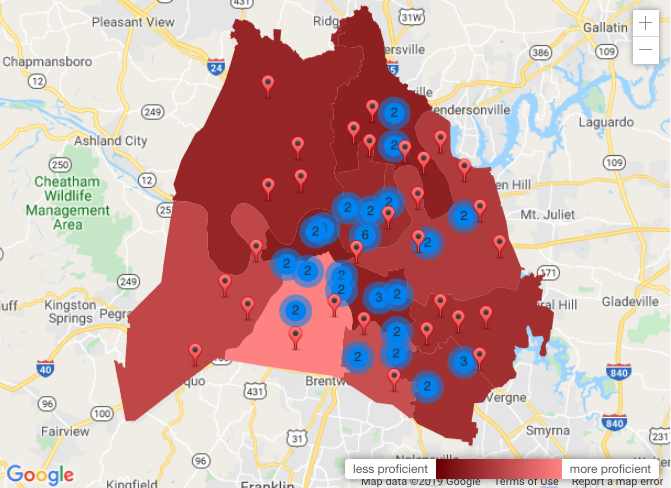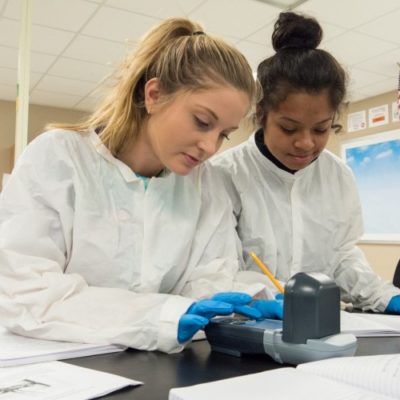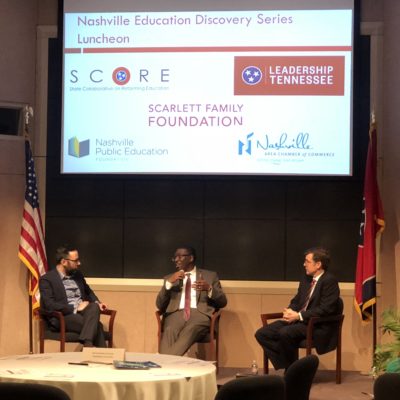
Nashville’s Third Grade Literacy Challenge: Where do we go from here?
In 1993, in its education report card, the Nashville Chamber of Commerce named literacy as a significant issue plaguing Metro Public Schools. 26 years later, this warning has snowballed into what can only be called a public crisis. In the year 2019, seven out of ten third-graders in Metro Nashville Public Schools (MNPS) cannot read at grade level – approximately 4,500 children in total.
According to a study by the Annie E. Casey Foundation, students who are not reading proficiently by the end of third grade are four times more likely to leave high school without a diploma than a proficient reader. As these students struggle to keep up with their peers academically, through fourth grade and beyond, the process of dropping out begins – a fate that research connects to higher rates of incarceration, along with other social repercussions. In Nashville, the lack of a high school diploma also carries startling economic implications. According to the Nashville Chamber of Commerce’s 2018 Vital Signs report, a local resident with no high school diploma will earn $23,389 on average – about $1,800 below the federal poverty line for a family of four.
But ultimately, no child’s future can be predicted with certainty, and Nashvillians should strive to set all children on a path to success in their earliest days. In some ways, the overall health of a community depends upon it. The Blueprint for Early Childhood Success tells us that “every child without a high school diploma costs society an estimated $260,000 in lost earnings, taxes and productivity [per year] – a number that will increase dramatically as low-skills jobs continue to disappear and demand for skilled work increases.”
Nashville’s struggle to turn its youngest residents into skilled, lifelong readers has been publicly acknowledged by city leadership, and has inspired a rise in both enthusiasm for and resources dedicated to fighting the early literacy crisis. In fact, a concrete goal was articulated as part of the city-wide Blueprint for Early Childhood Success initiative: to double the number of third-grade students reading on grade level by 2025. But with only 3 out of 10 Nashville third-graders achieving proficiency in English Language Arts in 2019, it is clear we are not moving the needle quickly enough.
To spotlight our city’s literacy crisis, the Scarlett Family Foundation recently released an interactive data tool focused specifically on third grade literacy rates in Nashville. We recognize that the proficiency numbers listed on this data map do not exist in a vacuum; there is context to every school community, involving factors such as poverty, proximity to resources, percentage of non-native English speakers, and so on. But if we allow these numbers to serve as starting points for discussion, they may have the power to inspire community-wide action that leads to real, tangible improvement for Nashville’s students.
Takeaways from the Third Grade Literacy Data Tool
As previously mentioned, the last few years of available testing data reveal that the percentage of Nashville third graders reading on grade level has barely moved from year to year— both districtwide and for key student subgroups. Only 15% of economically disadvantaged students and 20% of Black/Latino/Native American students are reading on grade level.
The data indicate some variance across school type, with 30.1% of students at public charter schools testing ON track compared to 25.6% at traditional MNPS schools. In Metro Nashville’s magnet schools, significantly more students (43%) are on track in English Language Arts.
But this discrepancy pales in comparison to that seen amongst the various geographic regions of Nashville. Literacy rates are at their lowest in the Pearl Cohn cluster, where only 13% of students on track, followed closely by the Hunters Lane cluster (15%). Comparatively, the Hillsboro (59%), Hillwood (34%) and Overton (37.5%) clusters see significantly higher rates of third-grade reading proficiency, though still far from acceptable. This correlation between literacy rates and geographic location points to a glaring inequity in our city – no child’s academic future should be dictated solely by the neighborhood in which they live.
Some notable improvements in third grade literacy are found across clusters, with two elementary schools standing out as bright spots for growth over the past three years— Napier Elementary and Crieve Hall Elementary.
Napier Elementary, in the Glencliff Cluster, moved from N/A (meaning less than 5% of students tested on track) in 2017 and 2018, to 17% students testing on track in 2019. Crieve Hall, serving students in the Overton Cluster, saw approximately 40% of students on track in both 2017 and 2018. That number increased significantly in 2019, with 67% of students measuring at the on-track level.
Explore the state of third grade literacy in your neighborhood by visiting our Data Tool here.
We have the data that proves the problem. How do we move closer to a solution?
As a city, we’ve articulated a bold, worthy goal: to double the number of third-graders reading on grade level by 2025. But with growth stagnant, what are we as Nashvillians prepared to do to see real improvement?
Start Early, and Empower Parents
A child’s relationship with reading should begin in their earliest days – making the home, the childcare center, or the preschool a perfect place to introduce young children to words, books, and texts of all kinds.
Nashville Public Library (NPL) stands as a hub for reading-readiness resources and programming. NPL’s Bring Books to Life is a free early literacy outreach program that operates in over 150 preschools, pre-k programs, and child care centers across Nashville. The Library equips teachers with the strategies and tools that will allow them to bring age-appropriate literacy practices into the classroom and provide workshops for parents and caregivers that will help create a culture of reading at home.
Almost 1,000 children are registered for the Library’s Read to Rise program, which helps parents get intentional about story-time with the goal of building a habit of daily reading in the home. Additionally, the Ready Rosie application provides quick videos demonstrating how parents or caregivers can incorporate literacy, math and social emotional learning practices into their family’s daily life. With these tools, parents can become better teachers of and future advocates for their young readers.
Not a parent of young children? Volunteer or donate books.
Consider volunteering time or resources to students in need. Through local organizations like PENCIL and Book’em, volunteers can be connected to MNPS students who have been identified as requiring reading intervention. Book’em also welcomes community members to host book drives, an important part of making sure all Nashville students have access to books. An up-to-date listing of open volunteer opportunities across the city can be found through Hands On Nashville.
Raise Your Voice
It’s important to recognize that YOU have the power to make profound change in the lives of MNPS students; and in order for third grade literacy rates to improve at a transformational level, we must all come together to see this issue as a city-wide priority. If the data presented in the Third Grade Literacy Data Tool is shocking to you, tell your elected officials. Make your voice heard by contacting your school board member, your Council Member, and the Mayor’s Office. Let our city’s leaders know that early childhood literacy must remain at the top of Nashville’s priority list if we are ever to truly live up to our “It City” title, and ask them what they plan to do to bring all students up to grade-level reading proficiency.
If we as a community truly believe that literacy is fundamental to our city’s health, we must raise a collective voice and demand more for the children at risk of being left behind.



